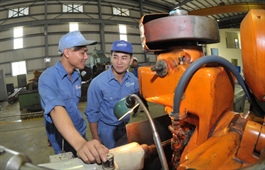Footwear sector further penetrates global supply chain
Footwear sector further penetrates global supply chain
Viet Nam's footwear sector is now beginning to see positive signs after export revenue for footwear and handbags fell 11 per cent year-on-year to US$19.5 billion in 2020, making it one of the sectors hardest hit by COVID-19.

Vietnamese companies have proved their capacity in research and development (R&D) and design, according to Chairman of the Vietnam Leather, Footwear and Handbag Association (LEFASO) Nguyen Duc Thuan.
Signs show that Viet Nam is further penetrating into the leather-footwear supply chain, he said, as the design and R&D processes rake in high added value for products.
The domestic supply of materials for the sector now represents 60 per cent. Local businesses can take the initiative in producing soles and moulds, as well as packaging and labelling. This is attributable to their activeness in manufacturing materials locally, Thuan added.
In particular, the Gia Dinh Footwear JSC has set up industrial clusters to attract investment in material production and workshops serving the industry. Its CEO Nguyen Chi Trung said orders for the footwear sector have been on an upward trend since the end of 2020.
As order numbers have recovered and are even on the rise, all workers have been able to return to production.
Shortages are likely, though, as there will be high demand for workers in April and May, Trung said.
Other firms in the sector are also hoping that 2021 will see a surge in both orders and revenue thanks to advantages held post-pandemic.
Of particular note, the EU-Vietnam Free Trade Agreement offers a major opportunity for the country to bolster exports to the EU.
Footwear companies have been advised to pay due regard to sustainable development, most notably in environmental and labour issues, to devise suitable strategies.
Thuan noted that the sector had set a target of earning more than $20 billion in exports this year, to offset losses posted in 2020.























